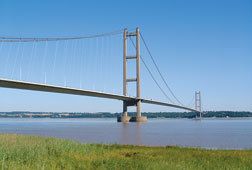
Forth Estuary Transport Authority |

Forth Estuary Transport Authority Inspected cables on Forth will receive dehumidification.
|
All three of the U.K.’s major suspension bridges have fallen prey to main-cable rusting, and dehumidification is the preferred cure. Work on the oldest structure, the Forth Road Bridge, is now starting. The Severn and Humber bridges are next in line.
“All Japanese suspension bridges are now fitted with dry-air injection as a preventative measure,” says the Forth’s general manager and bridgemaster, Alastair Andrew. But work on the Forth will be the first use of dehumidification “to slow down, or at best stop, corrosion,” he says.
With a 1,006-m-long main span, the 43-year-old Forth bridge carries some 24 million vehicles a year. “It is a well-maintained bridge,” says Andrew, who said he was amazed to find extensive corrosion. The Forth Estuary Transport Authority (FETA) adopted U.S. guidelines, published in 2005, for intrusive cable inspection. “You can imagine our surprise when in the first cable we unwrapped, some of the wires started to fall out,” says Andrew. “We had no evidence of water seeping from the main cables.”

|
British firm C. Spencer Ltd. probed 6-m lengths of 4% of the total cables for FETA. Cable strength loss is estimated at 8% to 10%. Traffic restrictions would be needed in 2014, says Andrew. As that sample is small, FETA last year had Paris-based Advitam
SA install 15 microphones on the structure, for around $2 million, to listen for breaking wires. Andrew reports five so far. If necessary, FETA will also inspect those sections intrusively.
For a remedy, FETA looked to Japan, where injecting dry air into parallel wire cables has become the norm, says Andrew. FETA’s consultant, Faber Maunsell, is being supported by Nippon Steel, which has extensive dehumidification experience. Starting in July, C. Spencer will double-wrap and heat-seal the cables with 25-cm-wide neoprene strips, says its contract manager, Kevin Griffiths.
Both cables will be wrapped and air- tight by late 2009. Meanwhile, the first of three dehumidifying modules is due this July from the Swedish manufacturer Munters A.B., Tobo. Measuring 9 m long, 2.8 m wide and 2.3 m deep, the biggest unit will contain six fans and sit in the deck midspan. Two four-fan modules will sit on the deck. Four one-fan sets will sit near the cable saddles.
Spencer’s $16-million contract in-cludes monitoring air flow for two years, says Griffiths. The goal is 40% hu-midity, at which corrosion is expected to cease. He hopes that level will be reached in about six months. For the longer term, Glasgow-based W.A. Fairhurst & Partners with Amman & Whitney, New York City, late last year began studying cable replacement.
Due late this year, the engineers’ findings will be influenced by government plans for a second Forth tunnel or bridge. A team led by Jacobs U.K. Ltd., Glasgow, is expected to present recommendations on the crossing to the Scottish Executive this summer. If timed well, the new route could take traffic off the Forth, easing cable replacement, says Andrew.
Cable corrosion is worse on the 41-year-old Severn Bridge with a 988-m main span, some 600 km south of Bristol. C. Spencer has completed intrusive tests of its main cable, says Griffiths. The U.K. Highways Agency has imposed load restrictions and ordered trial low-level dehumidification this summer.
With the Humber Bridge just 26 years old, Bridgemaster and General Manager Peter Hill is “pretty confident we will have no loss of strength.” The 68-cm-diameter cables support a 1,401-m main span that was the world’s longest until 1998. “We expect to find some deterioration,” he adds. Hill plans intrusive tests and acoustic monitoring this summer.

Post a comment to this article
Report Abusive Comment